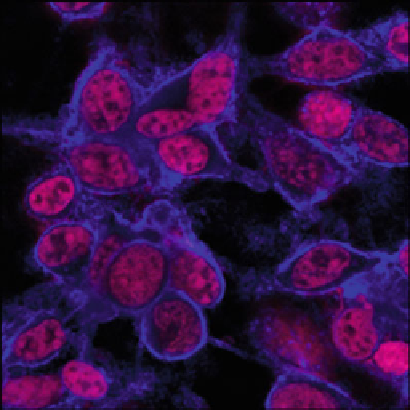Biomedical Engineering Reference
In-Depth Information
Fig. 34 Mouse tumor cells
(
blue
) showing penetration of
anticancer drug after 24 h.
Cancer cells have taken up a
chimeric polypeptide-drug
combination, shown in
magenta
. (Adapted from
[
110
])
vehicle breaks down into harmless byproducts, markedly decreasing the toxicity for
the recipient.
Nanoscale delivery systems have become increasingly attractive to researchers
because of their ability to efficiently get into tumors. Since blood vessels supplying
tumors are more porous, or leaky, than normal vessels, the nanoformulation can
more easily enter and accumulate within tumor cells. One such example is shown in
Fig.
34
; mouse tumor cells show penetration of anticancer drug after 24 h. Cancer
cells have taken up a chimeric polypeptide-drug combination This means that
higher doses of the drug can be delivered, increasing its cancer-killing abilities
while decreasing the side effects associated with systematic chemotherapy.
7.4 Mechanism of Nanoparticle Internalization
Peptide coatings can help nanoparticles slip into cells. Anas, Ishikawa, Biju and
coworkers with Japan's National Institute of Advanced Industrial Science and
Technology had a better idea after thoroughly studying the insect neuropeptide
allatostatin and learning that it helps CdSe-ZnS QDs pass through cell membranes
by recruiting clathrin, a protein that facilitates endocytosis by forming vesicles
around foreign substances [
47
] (Fig.
35
). The researchers suspected that allatostatin
might be gaining access to cells via galanin receptors. But when they blocked those
receptors, it did not have much influence on the influx of QDs. By inhibiting PI3K, a
kinase that is crucial to the formation of clathrin vesicles, they noted that fewer than
half of the QDs made their way in, hence indicating that most of the nanoparticle
entry is clathrin-mediated.

